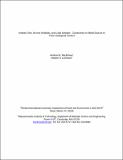Andean Ores, Bronze Artifacts, and Lead Isotopes: Constraints on Metal Sources in Their Geological Context
Author(s)
Macfarlane, Andrew W.; Lechtman, Heather Nan
Download10816_2014_9225_ReferencePDF.pdf (3.145Mb)
OPEN_ACCESS_POLICY
Open Access Policy
Creative Commons Attribution-Noncommercial-Share Alike
Terms of use
Metadata
Show full item recordAbstract
With a focus on bronze production in the south-central Andes during the Middle Horizon, this study reports the first archaeological use of lead isotope analysis to investigate metallic ores and metal artifacts in the Andean zone of South America. Because the vast majority of metal deposits in the Andean cordillera formed in a convergent plate boundary setting, lead isotope compositions of most Andean ore sources are not unique. Lead isotope ratios of central and south-central Andean ores define four geographically distinct ore lead isotope provinces, oriented and elongated parallel or sub-parallel to the trend of the Andean cordilleras. Consequently, ore lead isotope ratios vary strongly from west to east along transects through the coast, highlands, and altiplano, but they exhibit much less variation from north to south. The strong west-to-east variation in ore lead isotope signatures allows discrimination between ore bodies, and ultimately between metal artifacts, as a function of macro-ecozone location: coast, junga-qiswa, puna, and altiplano. We present the most up-to-date database of ore lead isotope signatures for the south-central Andes including those determined for ores we sampled over an approximate 250,000-km[superscript 2] region within Bolivia, northern Chile, and northwest Argentina. Lead isotope signatures of Cu-As-Ni bronze artifacts from Tiwanaku (altiplano capital) and San Pedro de Atacama (desert oasis entrepôt) establish that altiplano and high sierra ore bodies provided the metal for both assemblages. Conchopata (Wari) arsenic bronze artifacts exhibit lead isotope ratios compatible with the Julcani (Huancavelica) copper sulfarsenide deposit.
Date issued
2014-11Department
Massachusetts Institute of Technology. Department of Materials Science and EngineeringJournal
Journal of Archaeological Method and Theory
Publisher
Springer US
Citation
Macfarlane, Andrew W., and Heather N. Lechtman. “Andean Ores, Bronze Artifacts, and Lead Isotopes: Constraints on Metal Sources in Their Geological Context.” Journal of Archaeological Method and Theory 23.1 (2016): 1–72.
Version: Author's final manuscript
ISSN
1072-5369
1573-7764